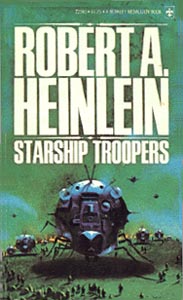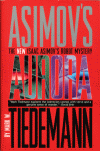
The 1959 novel Starship Troopers is a military-based science fiction novel which won the Hugo Award for best novel in 1960. Robert A. Heinlein clearly draws from his previous military experience to describe the career of Juan “Johnny” Rico as he works his way up from a fresh recruit to 2nd Lieutenant in the Terran Federation military during the “Bug War”.
The story is told through a series of flashbacks narrated by Rico, intertwined between these are obvious commentaries on discipline, politics, and human behavior. Heinlein’s concepts, specifically mechanical armor, influenced science fiction in various realms ranging from other novels to games, and even spawned a Hollywood motion picture. I’ve seen the movie Starship Troopers (1997) before, and will watch it again soon, so keep an eye out for that review.
First, let me give you a bit of a background on the setting of Starship Troopers. The novel begins during the middle of the First Interstellar War. There are two alien races known to humans. The aggressive aliens known as the Bugs, duly named for their arachnid physiology, have assaulted the Terran Federation. The Skinnies, named after their thin physiology, are allies with the Bugs, but are not directly attacking.
The novel starts with a combat drop taking place after Rico’s Lieutenant was killed during the line of duty. This operation is designed to break the will of the Skinnies and force them to side with the Terran Federation. The chain of command has shifted and he is moved up to assistant section leader for this mission, in charge of a whole section of cap troopers for the first time. Essentially each trooper, encased by a sophisticated powered armor exoskeleton, is launched from space in a capsule, hence the name cap trooper. What follows is a detailed description of the combat style of the Mobile Infantry division (MI for short) as they obliterate a city.
Heinlein does an excellent job of describing the inner-workings of the armor, which seamlessly augments the movement of the soldiers while giving them access to a wide range of information from various sensors and communications channels. The MI armor is divided up into three classes; Marauder, Scout, and Command. Each has their own strengths and weaknesses, explained in detail by dispersing bits and pieces of information throughout the novel. Most of the workings are unveiled during combat training or live maneuvers, but some of the details such as maintenance take place ship-side.
I was amazed at how awesome this MI armor system was, and was disappointed that it was completely left out of the Hollywood movie version. This advanced technology enabled a small group of highly trained soldiers to lay waste to entire cities (as described in the first chapter) with relative ease. This is much different than the traditional infantry described in the Movie. Aside from the 2nd chapter, 13th chapter, and the general details about Bug physiology, there isn’t much of the book reflected in the movie. Rico’s boot camp experiences are marginalized and his subsequent advancement in the military is completely left out, which is one of the strongest parts of this novel.
Getting away from book and movie comparisons, I have to mention that this was one of my faster reads in recent memory. I finished the book, which wasn’t very long at 262 paperback pages, in just 4 sittings. I don’t read very fast, but usually I just read a few chapters at a time here and there. Heinlein kept me glued to the book, and when I wasn’t reading I was wondering what would happen next.
One of the most important commentaries Heinlein makes in this novel is on the subject of behavior and discipline. In this not so distant future there is virtually no crime, as punishments such as public caning are handed out in order to keep the population in line. This seems extreme, but the relative embarrassment of having to be disciplined in public, shaming one’s family, is a strong deterrent.
The analogy of housebreaking a dog was used, quite ingeniously, to modeling behavior in children. In this future world there was a time when children ran rampant, robbing, killing, and terrorizing the rest of the public. Heinlein suggests that the slaps on the wrists, such as a few months of detention, were insufficient in teaching moral values. In the matter of capital punishment he points out that it is silly to expect a person to suddenly be responsible for their actions when they turn 18, especially when they’ve never been properly disciplined.
Another important facet of society is the fact that in order to earn the right to vote, people must serve in the military for at least 2 years to earn full citizenship. Anyone can join up, and if they can’t cut it can easily opt out of service with no repercussions other than they will never get the right to vote. All other liberties normally valued in democracy are still there for those that have not completed military service.
I think one of the more thought provoking observations Heinlein makes about human behavior is that we generally will sacrifice ourselves to save others. Heinlein speaks through Rico describing the difference between the Bugs and Humans:
Our behavior is different. How often have you seen a headline like this? – TWO DIE ATTEMPTING RESCUE OF SMALL CHILD. If a man gets lost in the mountains, hundreds will search and often two or three searchers are killed. But the next time somebody gets lost just as many volunteers turn out.
Of course the Bugs are based off of a hive mind, with easily replaceable workers and soldiers, so can’t possibly have the same values as Humanity. But why do we send a squad of Special Forces into enemy territory to save just one or two prisoners? I can’t imagine how many times more have died in the process of saving others in our real-life military history. Heinlein explains why through Rico’s monologue prior to an attempt to rescue prisoners of war through a huge offensive on the Bug home world of Klendathu.
The novel ends with a satisfying sense of closure, as events seem to come full circle. The situation is almost identical to the opening chapter, only the people in various roles are different. Rico has evolved into a combat-hardened veteran, surpassing many of his own expectations, offering last minute advice to his subordinates. He is now 2nd lieutenant leading an attack group, aided by a platoon sergeant (you’ll never guess who), and a fresh 3rd lieutenant straight from command school. I highly recommend this book, especially to anyone that likes military-based fiction, whether you are a science fiction fan or not.

